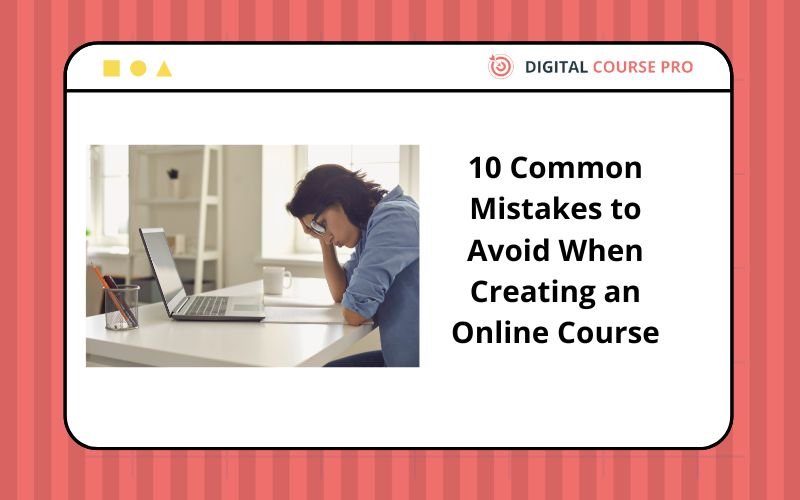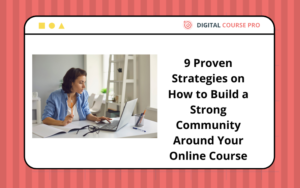Common Mistakes to Avoid When Creating an Online Course can derail even the most well-intentioned educators. As the demand for online learning continues to soar, course creators must navigate numerous challenges to deliver high-quality content that engages and educates learners. Here are ten common mistakes to avoid to ensure your online course stands out and succeeds.
1. Lack of Clear Objectives
One of the most common mistakes to avoid when creating an online course is failing to establish clear learning objectives. Without specific goals, your course can lack direction and coherence, leaving students confused about what they are expected to learn. Define clear, measurable outcomes to guide your content creation and help learners understand the benefits of your course.
2. Overloading Content
Trying to cover too much information can overwhelm learners and dilute the key messages of your course. Avoid the temptation to include every detail. Instead, focus on essential concepts and skills, breaking down complex topics into manageable segments. This approach helps maintain student engagement and facilitates better understanding.
3. Ignoring Audience Needs
Not tailoring your course to your target audience is another common mistake to avoid when creating an online course. Understand your learners’ backgrounds, knowledge levels, and learning preferences. Conduct surveys or engage in discussions to gather insights. Customizing your content to meet their needs ensures relevance and enhances the learning experience.
4. Poor Course Structure
A poorly structured course can be difficult to follow and reduce learner engagement. Use a logical, organized structure with clear modules, sections, and lessons. Incorporate summaries, outlines, and clear transitions between topics to help learners navigate the material easily.
5. Lack of Engagement
Simply presenting information is not enough. Engaging learners through interactive elements like quizzes, discussions, and practical exercises is crucial. Incorporate multimedia elements such as videos, infographics, and animations to make the content more dynamic and engaging.
6. Inadequate Assessment Methods
Assessments are essential for measuring learner progress and reinforcing key concepts. Avoid relying solely on multiple-choice questions. Use a variety of assessment methods, including short answer questions, projects, peer reviews, and practical applications, to provide a comprehensive evaluation of learner understanding.
7. Neglecting Feedback
Failing to gather and act on learner feedback is a critical common mistake to avoid when creating an online course. Regularly solicit feedback through surveys, quizzes, and discussion forums. Use this information to identify areas for improvement and make necessary adjustments to enhance the learning experience.
8. Overlooking Accessibility
Ensure your course is accessible to all learners, including those with disabilities. Use accessible design principles, such as providing captions for videos, using clear and readable fonts, and ensuring content is navigable using keyboard shortcuts. Accessibility is not only a best practice but often a legal requirement.
9. Technical Issues
Technical problems can frustrate learners and hinder their progress. Test your course thoroughly to ensure all links, videos, and interactive elements function correctly. Provide clear instructions and support resources to help learners troubleshoot common technical issues.
10. Failing to Update Content
The field of online learning is dynamic, with new information and technologies emerging constantly. Regularly review and update your course content to keep it current and relevant. Staying updated ensures your course continues to provide value to learners over time.
Conclusion
Creating a successful online course requires careful planning, attention to detail, and a deep understanding of your learners’ needs. By avoiding these Common Mistakes to Avoid When Creating an Online Course, you can enhance the quality and effectiveness of your content.
First, establish clear objectives to give your course direction and purpose. Avoid overloading content and focus on essential concepts to prevent overwhelming your learners. Tailor your course to your target audience by understanding their needs and preferences, ensuring that the material is relevant and engaging.
A well-structured course is crucial for maintaining learner engagement. Organize your content logically and use interactive elements to keep learners engaged. Assessments should be varied and comprehensive, providing a clear measure of learner progress. Regularly seek and act on feedback to continuously improve your course.
Accessibility should not be overlooked. Ensure your course is inclusive and accessible to all learners, including those with disabilities. Technical issues can hinder the learning experience, so thoroughly test your course and provide support resources for troubleshooting.
Finally, keep your content up-to-date. Regularly review and update your material to reflect the latest information and trends in your field. Staying current ensures your course remains valuable and relevant to your learners.
By addressing these Common Mistakes to Avoid When Creating an Online Course, you can create a high-quality, engaging, and effective online learning experience. Avoiding these pitfalls will not only enhance the learning outcomes for your students but also establish your reputation as a reliable and competent course creator. Embrace these best practices to ensure your course stands out in the competitive e-learning landscape and meets the evolving needs of your audience.
https://digitalcoursepro.com/10000-a-month-with-an-online-course-business/If you’re looking to transform your online course business into a thriving income source, check out our detailed guide on How to Make $10,000 a Month with an Online Course Business. Packed with actionable strategies, expert advice, and practical tips, this blog post will help you convert your passion into a steady revenue stream. Whether you’re new to course creation or aiming to expand your current offerings, our guide offers the essential insights and tools needed to achieve your financial goals. Visit our blog now to start your journey towards earning $10,000 a month!




